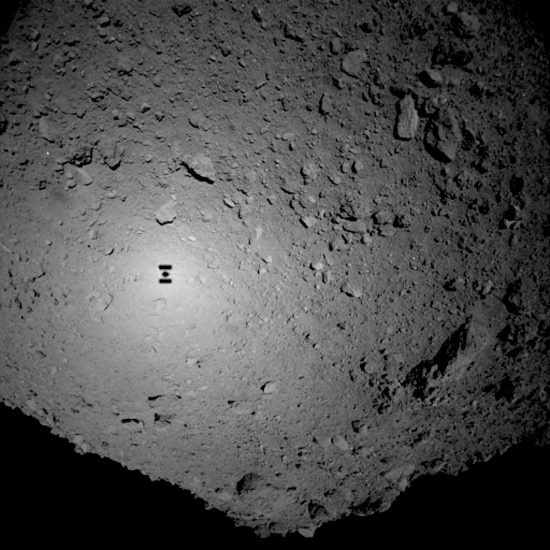
Hayabusa 2’s shadow over Ryugu on Friday, September 21, 2018. Credit: JAXA.
Sep 24, 2018
Five surface instruments are scheduled for Ryugu.
The Hyabusa 2 spacecraft is orbiting asteroid 162173 Ryugu, where, on September 21, 2018 it released two landers. Known as MINERVA-II, they “hop” from place-to-place on the surface. Since Ryugu’s gravity field exerts a mere .00012 m/s² acceleration (80,000 times less than Earth), the rovers need only a tiny push-off to drift and then settle somewhere else.
The same thing happened to the Philae lander deployed by the Rosetta Cometary Probe to connect with comet 67P/Churyumov–Gerasimenko, except inadvertently, when its attachment devices failed to deploy. Once a hold-down thruster cut-off, the lander leaped off the comet with the same thrust that was trying to keep it in place, causing it to tumble out of control, whereupon it met its end in the cold shadow of a cliff face.
Hyabusa 2 will send two more landers to the surface. A 10 kilogram device built in Europe called, MASCOT, along with an additional Minerva that will study surface composition. The three MINERVA landers will take pictures and conduct temperature measurements, as well, hopping across the asteroid to different locations.
Another object onboard is an impactor that will use high-explosives to send it crashing into the regolith. The mothership will then attempt to collect samples of the debris from beneath Ryugu’s crust for delivery back to Earth.
The JAXA mission to Ryugu is primarily one of exploration, since little is known about asteroids, in general. Space scientists are also interested in the environment around asteroids, because they want to send a manned-mission to a large one. According to NASA, their plans are to analyze electrical activity on various bodies to see if it could be a problem for astronauts.
Conventional astrophysicists think that solar wind ions cause asteroids to accumulate electric charge, because the magnetic fields accompanying charged particles from the Sun “… warp, twist, and snap as they slam into the magnetic fields around other objects…” Those fields are said to “knock” electrons from asteroids like a sand-blaster, increasing the positive charge in sunlit regions.
In an Electric Universe, asteroids, comets, and meteors all come from cosmic plasma discharges to rocky bodies like planets and moons. Their irregular shapes arise because plasma discharges form “dog-bones” or “potatoes” when semi-molten, often spinning, material is thrown out by an electric arc. Asteroid Gaspera is potato-shaped, for example, while Kleopatra is a dog-bone. They hold on to their charge signatures because the electric flux in interplanetary space is extremely low, less than 6 particles per cubic centimeter; not enough to neutralize the initial charge from their catastrophic parturition.
As previously written, rocky bodies in space with low apparent densities force astronomers to suggest the “rubble pile” model for asteroids. An electrical model insists that if it looks like solid rock, it probably is solid rock. The internal electrical state of comets and meteorites differs from the Earth, and this leads to erroneous density measurements. Astronomers do not agree with gravity’s electrical origin, so asteroid studies might miss the mark.
Stephen Smith












